IOT application in control system using wireless sensor fusion
A wireless controller based on data fusion algorithm and IoT technology is
designed and applied for an active QZS isolator. Firstly, an IoT sensor modular using
wireless instead of wired connection is proposed. The wireless sensors of acceleration,
velocity and distance are used in the active QZS isolator in order to eliminate unpredictable
disturbance causing by wire of sensors. Secondly, the data fusion algorithm embedded in
wireless sensor module is described to show how to combine acceleration, velocity and
distance data into one kind of information. The fuser with advanced fusion technique will
protect control system from a suddenly disabled sensor. Lastly, the system controller uses
data fusion to compute control signal for producing a governing force of the isolator. The
experiment result shows out 60% better eliminating vibration of the proposed controller.
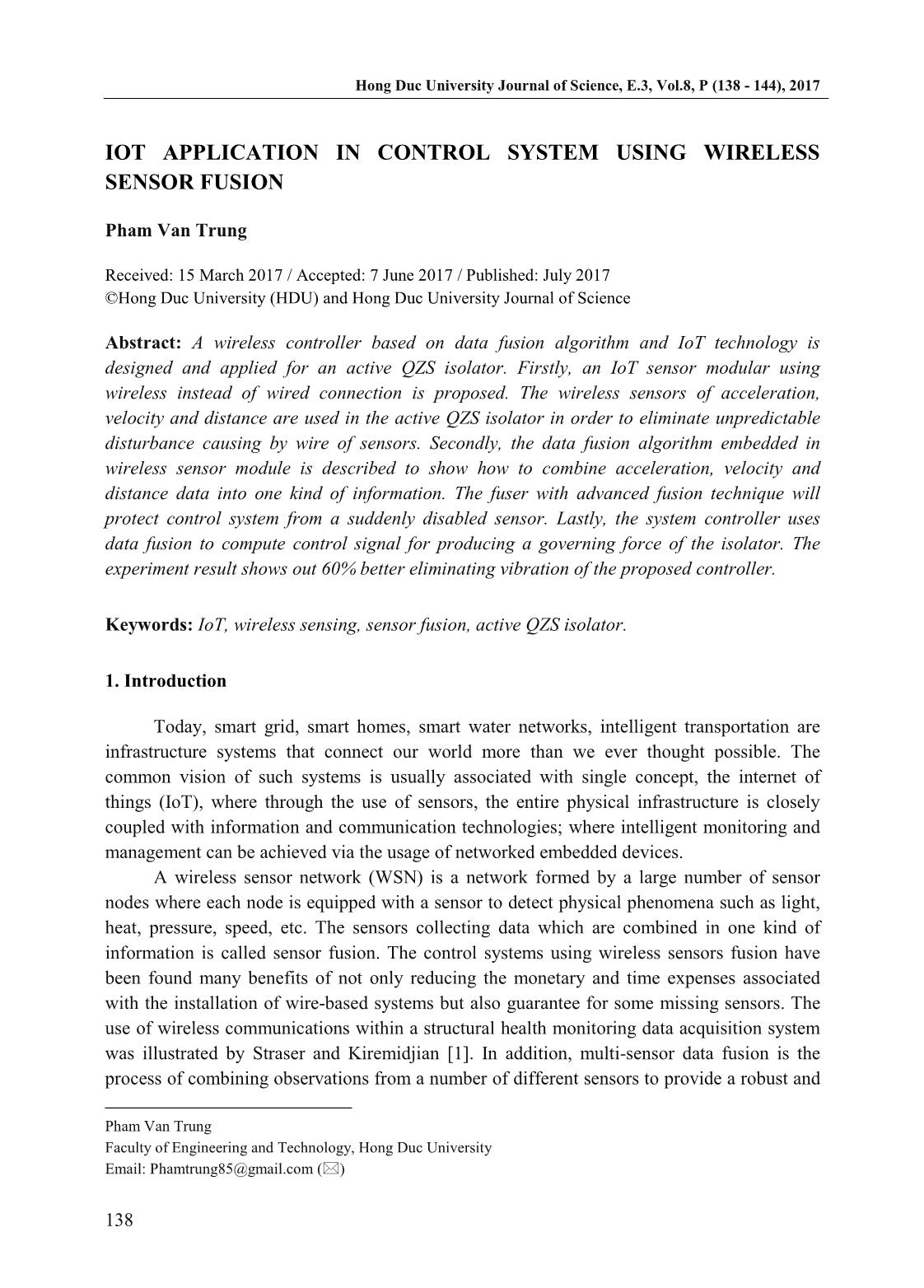
Trang 1
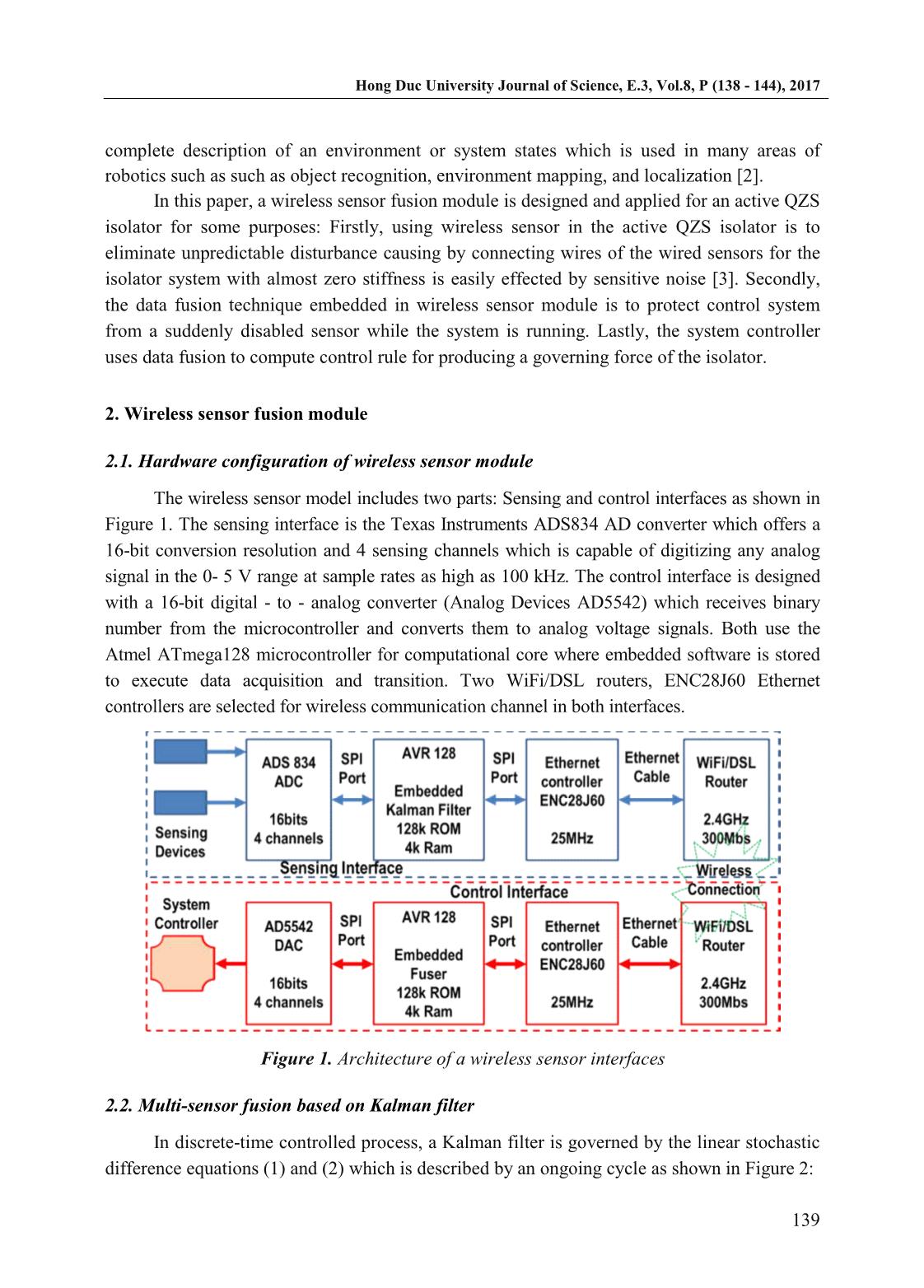
Trang 2
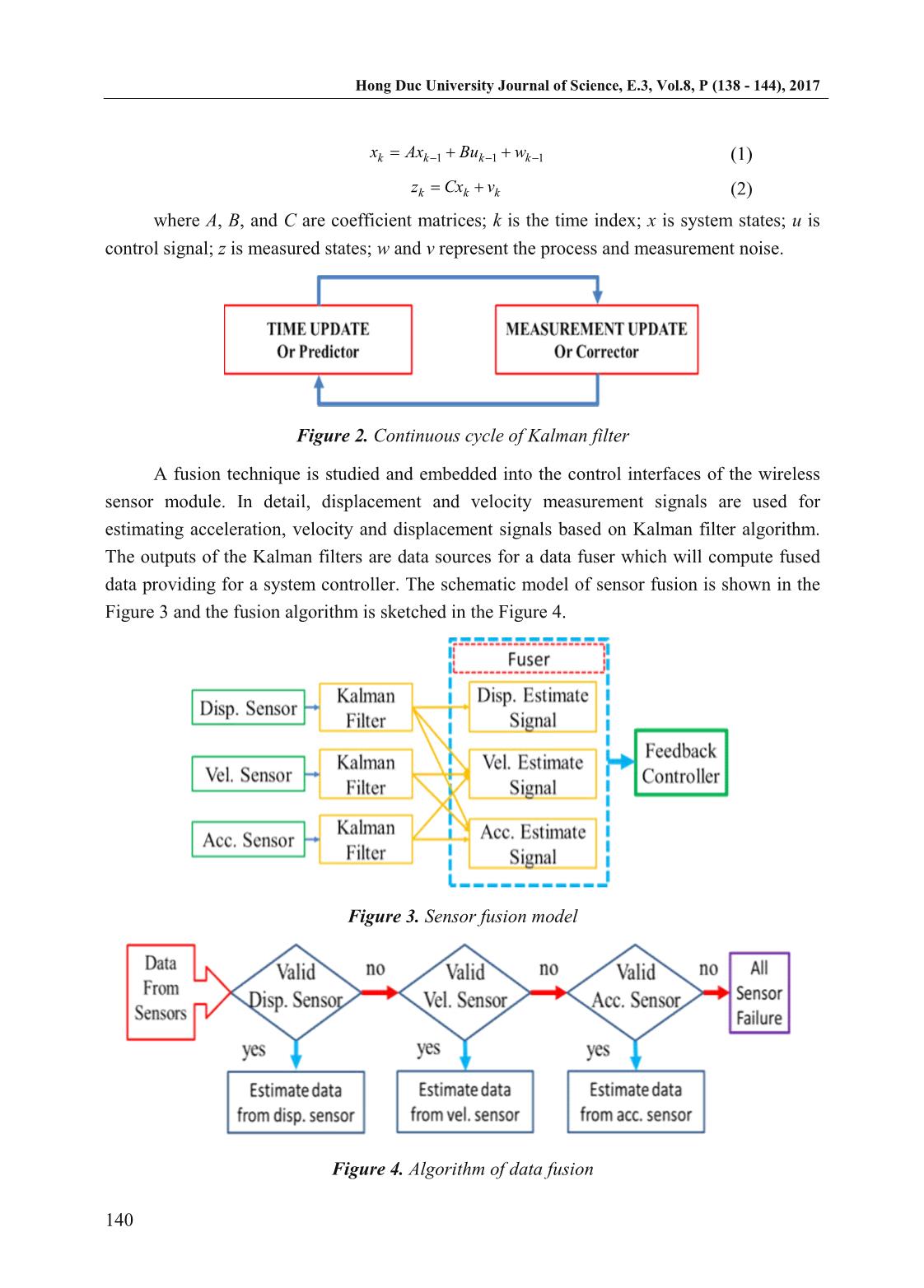
Trang 3
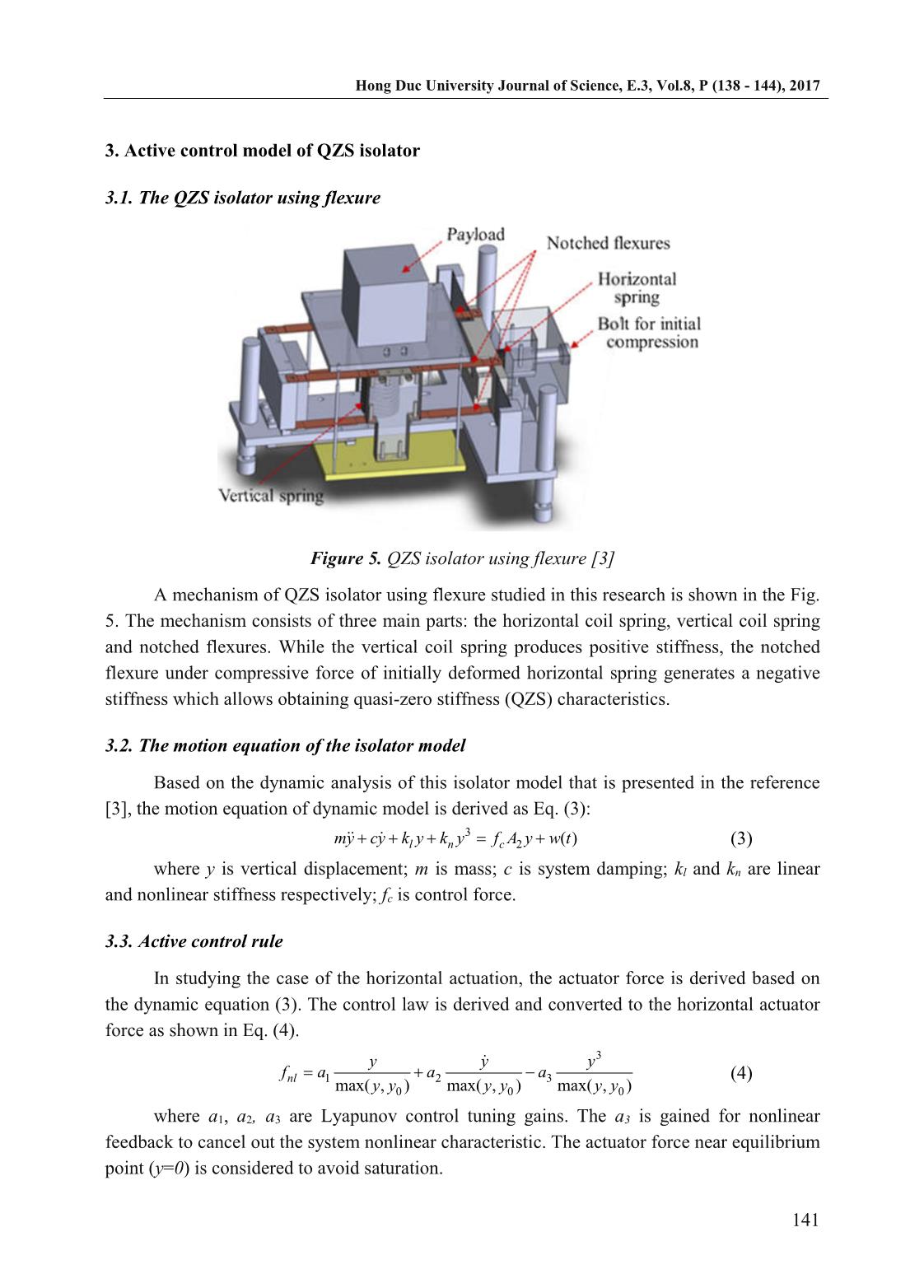
Trang 4
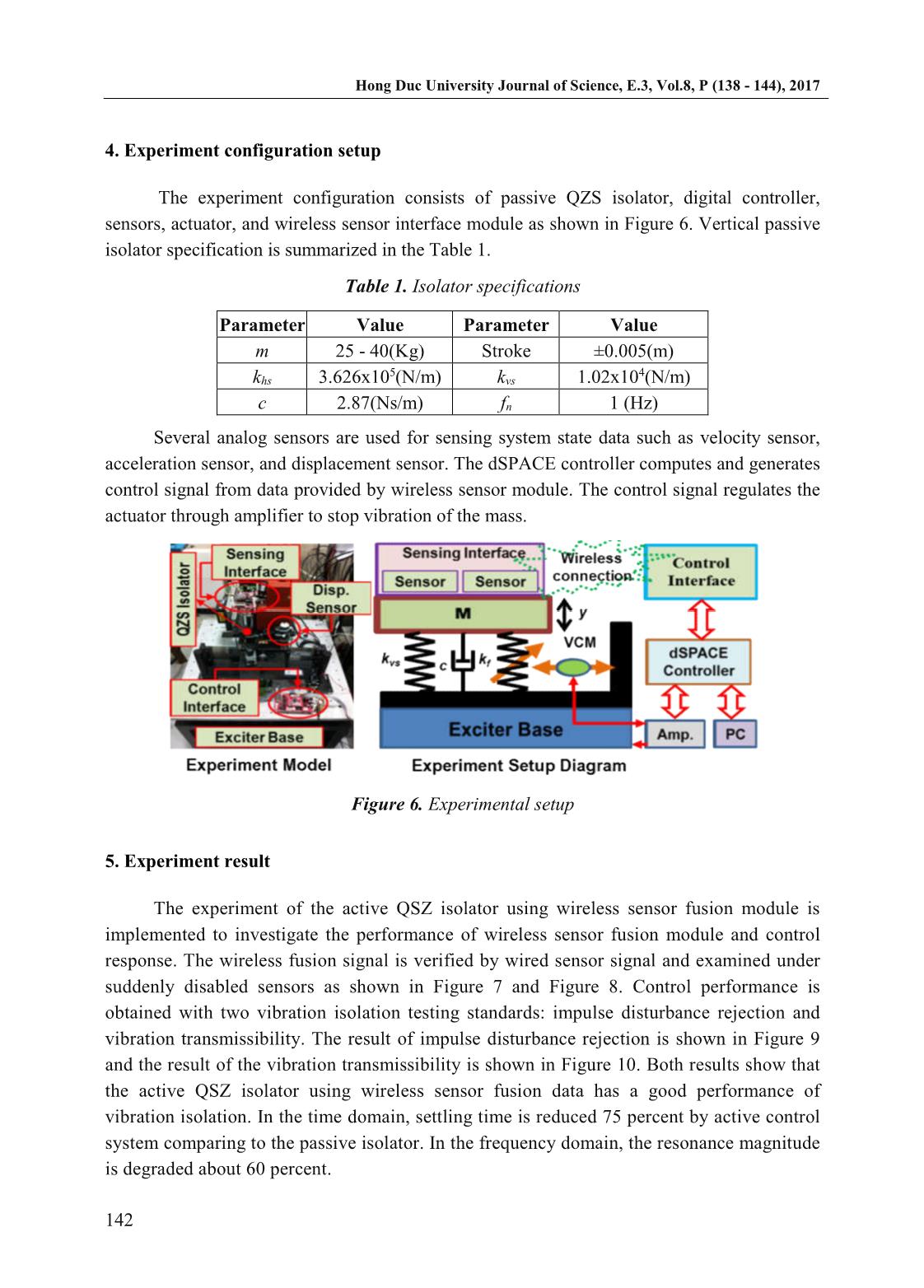
Trang 5
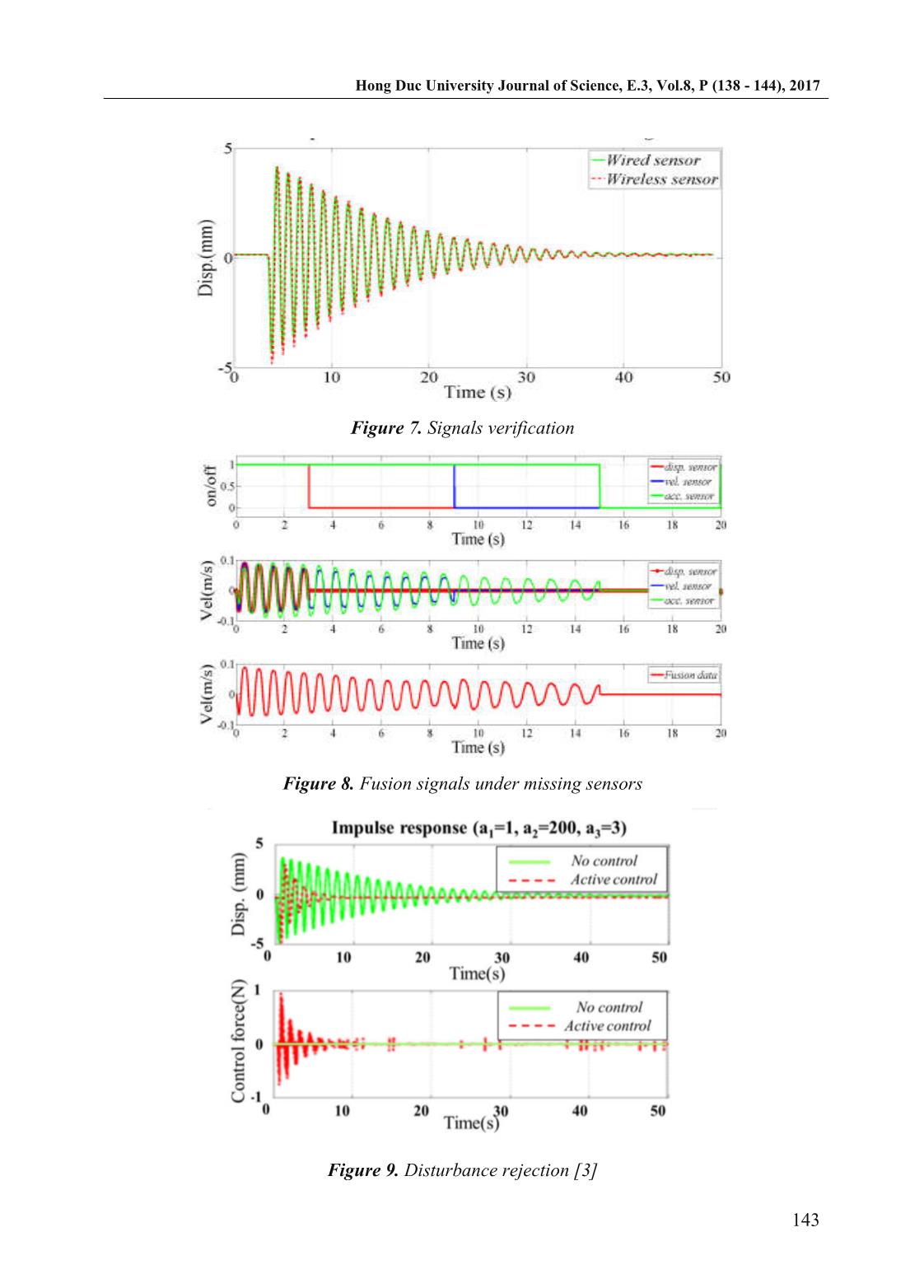
Trang 6
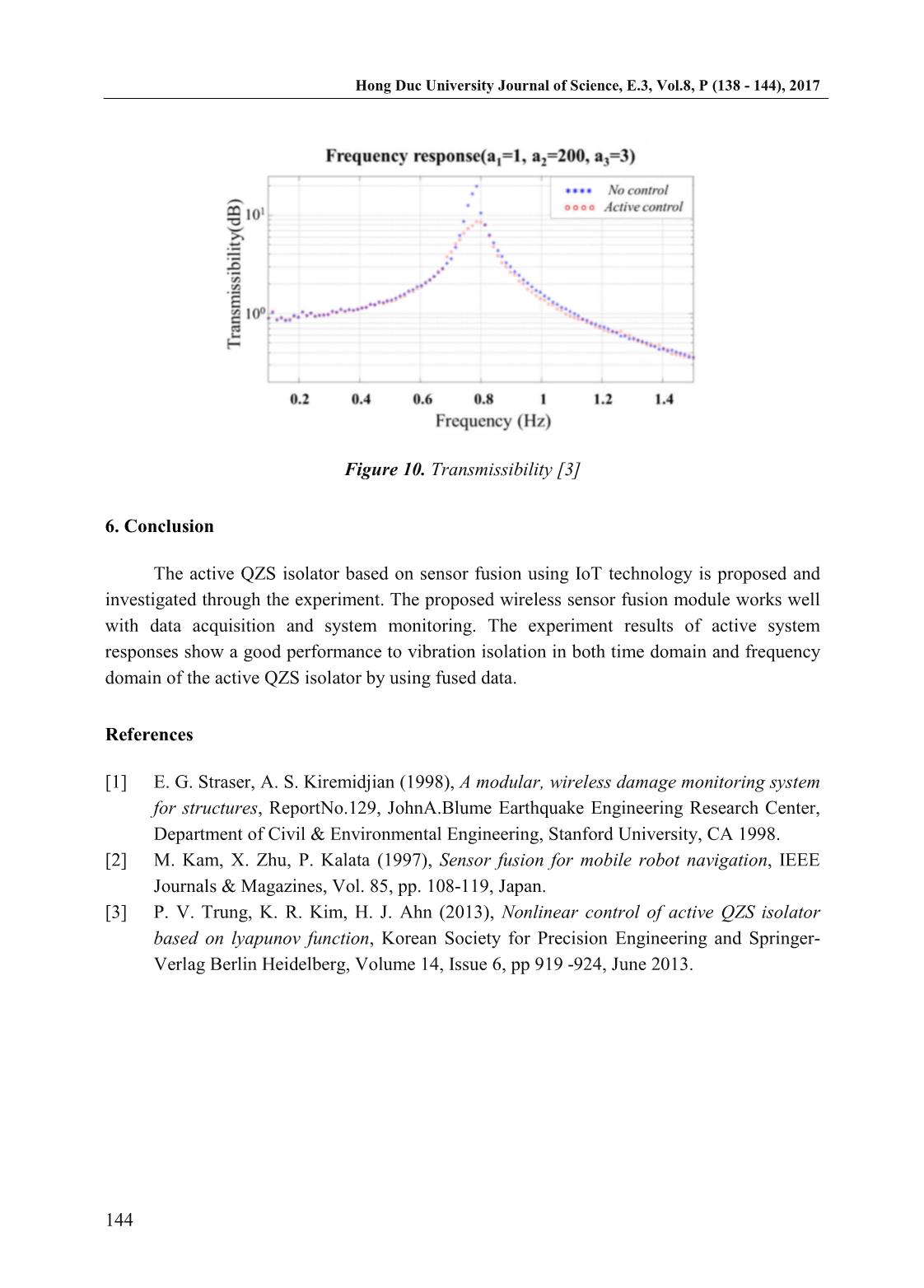
Trang 7
Tóm tắt nội dung tài liệu: IOT application in control system using wireless sensor fusion
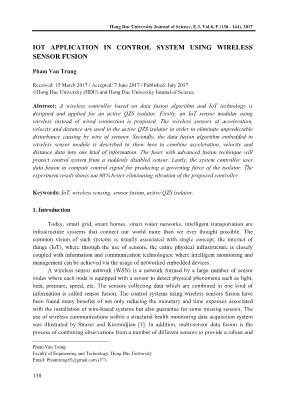
Hong Duc University Journal of Science, E.3, Vol.8, P (138 - 144), 2017 138 IOT APPLICATION IN CONTROL SYSTEM USING WIRELESS SENSOR FUSION Pham Van Trung1 Received: 15 March 2017 / Accepted: 7 June 2017 / Published: July 2017 ©Hong Duc University (HDU) and Hong Duc University Journal of Science Abstract: A wireless controller based on data fusion algorithm and IoT technology is designed and applied for an active QZS isolator. Firstly, an IoT sensor modular using wireless instead of wired connection is proposed. The wireless sensors of acceleration, velocity and distance are used in the active QZS isolator in order to eliminate unpredictable disturbance causing by wire of sensors. Secondly, the data fusion algorithm embedded in wireless sensor module is described to show how to combine acceleration, velocity and distance data into one kind of information. The fuser with advanced fusion technique will protect control system from a suddenly disabled sensor. Lastly, the system controller uses data fusion to compute control signal for producing a governing force of the isolator. The experiment result shows out 60% better eliminating vibration of the proposed controller. Keywords: IoT, wireless sensing, sensor fusion, active QZS isolator. 1. Introduction Today, smart grid, smart homes, smart water networks, intelligent transportation are infrastructure systems that connect our world more than we ever thought possible. The common vision of such systems is usually associated with single concept, the internet of things (IoT), where through the use of sensors, the entire physical infrastructure is closely coupled with information and communication technologies; where intelligent monitoring and management can be achieved via the usage of networked embedded devices. A wireless sensor network (WSN) is a network formed by a large number of sensor nodes where each node is equipped with a sensor to detect physical phenomena such as light, heat, pressure, speed, etc. The sensors collecting data which are combined in one kind of information is called sensor fusion. The control systems using wireless sensors fusion have been found many benefits of not only reducing the monetary and time expenses associated with the installation of wire-based systems but also guarantee for some missing sensors. The use of wireless communications within a structural health monitoring data acquisition system was illustrated by Straser and Kiremidjian [1]. In addition, multi-sensor data fusion is the process of combining observations from a number of different sensors to provide a robust and Pham Van Trung Faculty of Engineering and Technology, Hong Duc University Email: Phamtrung85@gmail.com ( ) Hong Duc University Journal of Science, E.3, Vol.8, P (138 - 144), 2017 139 complete description of an environment or system states which is used in many areas of robotics such as such as object recognition, environment mapping, and localization [2]. In this paper, a wireless sensor fusion module is designed and applied for an active QZS isolator for some purposes: Firstly, using wireless sensor in the active QZS isolator is to eliminate unpredictable disturbance causing by connecting wires of the wired sensors for the isolator system with almost zero stiffness is easily effected by sensitive noise [3]. Secondly, the data fusion technique embedded in wireless sensor module is to protect control system from a suddenly disabled sensor while the system is running. Lastly, the system controller uses data fusion to compute control rule for producing a governing force of the isolator. 2. Wireless sensor fusion module 2.1. Hardware configuration of wireless sensor module The wireless sensor model includes two parts: Sensing and control interfaces as shown in Figure 1. The sensing interface is the Texas Instruments ADS834 AD converter which offers a 16-bit conversion resolution and 4 sensing channels which is capable of digitizing any analog signal in the 0- 5 V range at sample rates as high as 100 kHz. The control interface is designed with a 16-bit digital - to - analog converter (Analog Devices AD5542) which receives binary number from the microcontroller and converts them to analog voltage signals. Both use the Atmel ATmega128 microcontroller for computational core where embedded software is stored to execute data acquisition and transition. Two WiFi/DSL routers, ENC28J60 Ethernet controllers are selected for wireless communication channel in both interfaces. Figure 1. Architecture of a wireless sensor interfaces 2.2. Multi-sensor fusion based on Kalman filter In discrete-time controlled process, a Kalman filter is governed by the linear stochastic difference equations (1) and (2) which is described by an ongoing cycle as shown in Figure 2: Hong Duc University Journal of Science, E.3, Vol.8, P (138 - 144), 2017 140 1 1 1k k k kx Ax Bu w (1) k k kz Cx v (2) where A, B, and C are coefficient matrices; k is the time index; x is system states; u is control signal; z is measured states; w and v represent the process and measurement noise. Figure 2. Continuous cycle of Kalman filter A fusion technique is studied and embedded into the control interfaces of the wireless sensor module. In detail, displacement and velocity measurement signals are used for estimating acceleration, velocity and displacement signals based on Kalman filter algorithm. The outputs of the Kalman filters are data sources for a data fuser which will compute fused data providing for a system controller. The schematic model of sensor fusion is shown in the Figure 3 and the fusion algorithm is sketched in the Figure 4. Figure 3. Sensor fusion model Figure 4. Algorithm of data fusion Hong Duc University Journal of Science, E.3, Vol.8, P (138 - 144), 2017 141 3. Active control model of QZS isolator 3.1. The QZS isolator using flexure Figure 5. QZS isolator using flexure [3] A mechanism of QZS isolator using flexure studied in this research is shown in the Fig. 5. The mechanism consists of three main parts: the horizontal coil spring, vertical coil spring and notched flexures. While the vertical coil spring produces positive stiffness, the notched flexure under compressive force of initially deformed horizontal spring generates a negative stiffness which allows obtaining quasi-zero stiffness (QZS) characteristics. 3.2. The motion equation of the isolator model Based on the dynamic analysis of this isolator model that is presented in the reference [3], the motion equation of dynamic model is derived as Eq. (3): 3 2 ( )l n cmy cy k y k y f A y w t (3) where y is vertical displacement; m is mass; c is system damping; kl and kn are linear and nonlinear stiffness respectively; fc is control force. 3.3. Active control rule In studying the case of the horizontal actuation, the actuator force is derived based on the dynamic equation (3). The control law is derived and converted to the horizontal actuator force as shown in Eq. (4). 3 1 2 3 0 0 0max( , ) max( , ) max( , ) nl y y y f a a a y y y y y y (4) where a1, a2, a3 are Lyapunov control tuning gains. The a3 is gained for nonlinear feedback to cancel out the system nonlinear characteristic. The actuator force near equilibrium point (y=0) is considered to avoid saturation. Hong Duc University Journal of Science, E.3, Vol.8, P (138 - 144), 2017 142 4. Experiment configuration setup The experiment configuration consists of passive QZS isolator, digital controller, sensors, actuator, and wireless sensor interface module as shown in Figure 6. Vertical passive isolator specification is summarized in the Table 1. Table 1. Isolator specifications Parameter Value Parameter Value m 25 - 40(Kg) Stroke ±0.005(m) khs 3.626x105(N/m) kvs 1.02x104(N/m) c 2.87(Ns/m) fn 1 (Hz) Several analog sensors are used for sensing system state data such as velocity sensor, acceleration sensor, and displacement sensor. The dSPACE controller computes and generates control signal from data provided by wireless sensor module. The control signal regulates the actuator through amplifier to stop vibration of the mass. Figure 6. Experimental setup 5. Experiment result The experiment of the active QSZ isolator using wireless sensor fusion module is implemented to investigate the performance of wireless sensor fusion module and control response. The wireless fusion signal is verified by wired sensor signal and examined under suddenly disabled sensors as shown in Figure 7 and Figure 8. Control performance is obtained with two vibration isolation testing standards: impulse disturbance rejection and vibration transmissibility. The result of impulse disturbance rejection is shown in Figure 9 and the result of the vibration transmissibility is shown in Figure 10. Both results show that the active QSZ isolator using wireless sensor fusion data has a good performance of vibration isolation. In the time domain, settling time is reduced 75 percent by active control system comparing to the passive isolator. In the frequency domain, the resonance magnitude is degraded about 60 percent. Hong Duc University Journal of Science, E.3, Vol.8, P (138 - 144), 2017 143 Figure 7. Signals verification Figure 8. Fusion signals under missing sensors Figure 9. Disturbance rejection [3] Hong Duc University Journal of Science, E.3, Vol.8, P (138 - 144), 2017 144 Figure 10. Transmissibility [3] 6. Conclusion The active QZS isolator based on sensor fusion using IoT technology is proposed and investigated through the experiment. The proposed wireless sensor fusion module works well with data acquisition and system monitoring. The experiment results of active system responses show a good performance to vibration isolation in both time domain and frequency domain of the active QZS isolator by using fused data. References [1] E. G. Straser, A. S. Kiremidjian (1998), A modular, wireless damage monitoring system for structures, ReportNo.129, JohnA.Blume Earthquake Engineering Research Center, Department of Civil & Environmental Engineering, Stanford University, CA 1998. [2] M. Kam, X. Zhu, P. Kalata (1997), Sensor fusion for mobile robot navigation, IEEE Journals & Magazines, Vol. 85, pp. 108-119, Japan. [3] P. V. Trung, K. R. Kim, H. J. Ahn (2013), Nonlinear control of active QZS isolator based on lyapunov function, Korean Society for Precision Engineering and Springer- Verlag Berlin Heidelberg, Volume 14, Issue 6, pp 919 -924, June 2013.
File đính kèm:
 iot_application_in_control_system_using_wireless_sensor_fusi.pdf
iot_application_in_control_system_using_wireless_sensor_fusi.pdf

